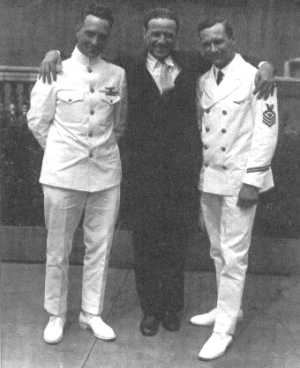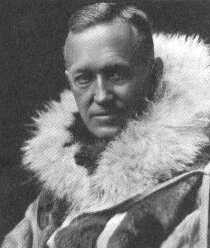|
Richard Byrd and
Floyd Bennett

Portrait of Richard Byrd.
Exploration of the uncharted areas of the globe by airplane
and airship became very active in the
1920s for a variety of
reasons. Looking forward to the establishment
of aerial transportation from
continent to continent, it
was necessary to know what aircraft were capable of,
whether aerial navigation
techniques were adequate, and
whether or not ground support could be provided en-route.
These reasons, combined with the general adventurousness
that pervaded the 1920s, led to
many path finding flights across
oceans and continents, but an
additional set of reasons came
into play in motivating aerial
exploration of the Arctic and Antarctic regions.

Three aviators pose at a dinner in their
honor at New York’s McAlpin Hotel. Known as “the three B’s of aviation,” they
are
Commander Richard E. Byrd (left) and Floyd Bennett (right)
in their
dress-white uniforms and Captain Homer M. Berry (Centre),
who was
already being feted as the pilot of the first New
York-to-Paris nonstop
flight, scheduled to take place some months in the future.
Berry was a
respected air hero of World War I, and there was little
doubt that he
would be the winner of the Orteig challenge. As it turned
out,
however, he was soon thereafter replaced as the pilot and
the aircraft
crashed on take-off
In the late twentieth century, it
is difficult to believe that as
late as the mid-1920s there was thought to be
land north of the Alaska in
the middle of the Arctic Ocean, in
an area known as the “blind spot,” in the middle of which
was the “Pole of Inaccessibility,” a point
equidistant from all land masses and
about four hundred miles
(643.5km) south of the North Pole. On official
charts, it was called Crocker Land or Keenan Land, and
appeared with question marks and purported outlines, arrived
at from unreliable sightings and calculations based on
measured anomalies of the currents passing through the
Bering Strait.
Three teams were deeply involved in the
aerial exploration of the Arctic: the Norwegians, led by the
famed explorer Roald Amundsen, who had
reached the South Pole over land in
1912; an American team headed
by Richard E. Byrd, a
lieutenant commander in the U.S. Navy; and a group
led by the Australian George H.
Wilkins, who sought and
accepted help from many sources.
First out of the gate was Amundsen.
After being forced
into bankruptcy in 1924 through mismanagement on the
part of a ship broker who had
failed to purchase planes for a
flight over the North Pole (after
all other provisions for the flight
were bought and paid for),
he teamed up with a wealthy
American who simply called him in
his New York hotel room
and offered to finance the expedition to
the North Pole, if he could come
along.
This was how Lincoln Ellsworth, by then a man of over
forty and with virtually no connection to
flying (he had flown some
in the war) and no Arctic experience, entered
the annals of Arctic aerial
exploration. Amundsen had the
resources now to purchase the
planes he needed. He and Ellsworth
acquired two Dornier-Wal all-metal
boat planes with two powerful
Rolls-Royce engines arranged in
tandem atop the wing. Amundsen and
Ellsworth took off in May 1925 in
two planes, the N-24 and the N-25,
each with a crew of three, from King’s
Bay, Spitsbergen.
Both planes were
forced down short of the Pole. In one
of the most dramatic feats of perseverance and
survival on record, all six
crew members managed to survive for
three weeks, repair one of the
planes (the N-25), and make
it back to Spitsbergen on June 15.
Amundsen and Ellsworth were
determined to try for the Pole again,
and in 1926 they purchased a semi-
rigid dirigible, the N-1,
from the Italian designer Umberto
Nobile. While they were preparing
the dirigible—renamed the Norge (or
“Norway”), much to the consternation of the Italians—for
flight, an American team arrived at King’s Bay.

Seen here is Lincoln Ellsworth, one
of the
great aviators in the grand tradition of
Arctic (specifically Alaskan) aviation.
The Americans had tried an over-the-pole
flight two years earlier, using three Loening amphibian
biplanes with open cockpits. The team, headed by Captain
Donald P. MacMillan and Richard E. Byrd, was sent by the
navy to find Crocker Land (or whatever was out there) and to
perform a flying feat that could diminish some of the lustre
of the army’s Douglas World Cruisers.
It was clear from the
start that the planes were not nearly durable enough,
especially not their landing gear, and MacMillan abandoned
the project. But Byrd and his very able pilot, Floyd
Bennett, sought private funding for another try. With the
help of Edsel Ford, Byrd purchased a Fokker Trimotor and
named it the Josephine Ford (much to Anthony Fokker’s
consternation). The third group to arrive in 1926 was headed
by George Hubert Wilkins, flying a Fokker Trimotor called
the Detroiter, and a single-engine Fokker called the
Alaskan.
He too had a talented pilot at his
disposal, a North Dakotan named Carl Ben Eilson who had
become the foremost Alaskan bush pilot. Wilkins was more
interested in exploring the “blind spot” than in making an
over-the-pole flight, hut the newspaper publishers who were
his hackers insisted that he try for being the first to fly
over the pole.

ABOVE: Flying over the Arctic was a
treacherous and dangerous undertaking.
Here, Amundsen (right) inspects the mono-plane in which he plans to attempt a fly-over of the North Pole; on the wing is his
mechanic, Oskar Omdal.
RIGHT After the
successful flight of Byrd and Bennett over
the Pole in 1926, the pair teamed up to
cross the Atlantic, but Bennett was injured
in the last test flight before the planned
attempt. Bennett (on crutches) is greeted by
Byrd in front of the America
Thus, as May 1926 dawned, the three teams
preparing to fly into the Arctic region were not really
competing with one another. The Detroiter was soon Out of
commission after its landing gear collapsed, and the
Alaskan, considered a hard-luck ship because a reporter had
been decapitated accidentally by the propeller, was not
powerful enough to make a polar flight. That left the field
to Amundsen and Byrd.
The newspapers promoted the notion that a
race was underway, but in fact, the two teams assisted one
another throughout the preparations. Bernt Balchen, a
Norwegian flier who had been sent to search for Amundsen
back in 1925 and who had become a close friend of Amundsen
and a valuable member of his crew, gave Byrd much advice
(with Amundsen’s blessing) on the best construction of
landing gear for the Arctic. Balchen would later be invited
by Byrd to join him in subsequent history-making flights.
(After Byrd’s death in 1957, Balchen claimed that Byrd had
not flown to the North Pole, but this claim was never
substantiated.) At 12:37 A.M. on May 9, 1926, Byrd and
Bennett took off in the Josephine Ford and flew toward the
North Pole. They reached the Pole (by Byrd’s calculations)
at 9:02 and circled for fifteen minutes taking pictures.
They had intended to return by way of
Cape Morris Jesup on the north-western corner of Greenland,
but an oil leak prompted them to take no chances and they
returned directly to Spitsbergen, arriving to cheering
Norwegians (and an uncharacteristically effusive Amundsen)
at 4:07 P.M. The Norge took off two days later, and while it
passed over the Pole and made it to Teller, Alaska, in just
under seventy-one hours, the flight was a torture to both
Amundsen and Nobile.
The two men were determined not to let
their countries be deprived of the honour that was due to
the nation that sponsored the first crossing of the Arctic
Ocean. Amundsen, a stoic, imperious-looking figure (hut by
all accounts a man of great warmth and humour), irritated
the excitable Nobile at every opportunity. None of the
crew of sixteen (and one dog) slept for the three-day
flight—the cabin was simply too cramped— but Amundsen
insisted on sitting in the only chair and mercilessly
needled Nobile and his Italian crew (who in truth knew much
more about dirigible flying than the Norwegians), believing
there was little point in even making the flight now that
Byrd and Bennett had reached the Pole.
It was considered the height of irony
when, in June 1928, Amundsen perished while flying a rescue
plane in search of Nobile and the !talia, a refitted version
of the Norge. Wilkins and Eilson returned to Alaska in the
spring of 1927 with two Stinson biplanes and attempted to
cross the Arctic from Point Barrow to King’s Bay. They
landed successfully and took off on the polar ice, the first
time an airplane had managed that feat, but they
crash-landed only sixty-five miles (104.5km) out of Barrow.
The fliers trekked over treacherous ice for more than
thirteen days, racing not only the cold, but the frostbite
that had set in to Eilson’s fingers and threatened to take
his entire arm if they did not reach help soon. They soon
made it to Beachey Point, an Eskimo trading post east
of Barrow, where Eilson was rushed to the hospital. (He lost
only One finger to the ordeal.)
A year later, Wilkins and Eilson were
back for another try. This time they flew one of the first
Lockheed Vegas produced. The plane performed excellently and
the flight, which began on April 15 and ended six days later
because of a five-day storm that the fliers waited out on
the ground, was hailed as one of the great Arctic flights of
the period. Wilkins was knighted and the pair became
international celebrities. Their flight had accomplished a
number of things. It demonstrated the capabilities of the
Vega, a plane that was to become a favourite of long
distance fliers for to years come. It put to rest once and
for all the notion that there was any land mass between
Alaska and the North Pole. And it demonstrated that
trans-Arctic flights might not be as dangerous as once
thought, which meant that great circle air routes from North
America to Europe and Asia should be seriously considered
for commercial aviation when planes improved.
Byrd received the Congressional Medal of
Honour for his Arctic flight (which makes Balchen’s later
claim all the more curious). Just as he had assisted the NC
aircraft crews and Alcock and Brown in their trans-Atlantic
flights, he provided navigational assistance to Lindbergh
for his historic 1927 flight. After a June 1927 flight
across the Atlantic with Balchen (Bennett was nursing a
broken leg at the time), Byrd turned his attention to the
Antarctic. By now an admiral and an international celebrity,
Byrd raised private funds with the help of Edsel Ford and
John D. Rockefeller, Jr., and began a period of adventure
and exploration that captivated the world from 1928 to
the mid-1930s.
Flying the Fokker Trimotor Floyd Bennett,
named after his pilot (who died in 1928 of pneumonia,
contracted while on a rescue flight in Canada), with Balchen
and two other fliers, Byrd flew over the South Pole on
November 29, 1928, setting yet another milestone in polar
aviation.
|
